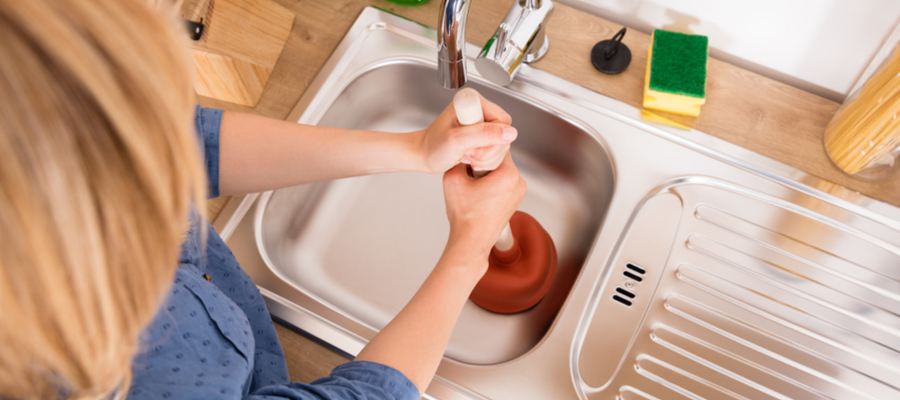
Drain clogs have a way of asserting themselves at the worst possible moment. Perhaps most frustrating is the slow drain. It still kind of works so you don’t want to hassle with it but at the same time, you know it’s not getting better on its own.
Obviously, the best way to clear a clog is to call in the pros to help you. But, if you want to roll up your sleeves and try to clear that slow moving drain yourself, we’ve got tips. Here are five strategies that might just get things flowing again:
Plunge It
A plunger is the first thing you should try when trying to clear a slow drain. If something is clogging your sink drain, you’ll probably want to use a cup plunger to clear it. The cup on a cup plunger will fit snugly over the sink’s drain to create an effective vacuum.
First, completely remove any excess water standing in the sink. Then, remove the drain cover to expose the open drain. Place the cup plunger over the drain. Make sure the cup fits over the drain completely. Pump the plunger up and down for 30 seconds to one minute. Run water, allow that water to drain, and repeat this process up to three times.
Vinegar and Baking Soda
This is a classic homemade drain cleaner. Start by pouring ⅓ of a cup to 1 cup of dry baking soda down the drain. Try to send the baking soda as far down the drain as you can. Then, follow the baking soda with an equivalent amount of vinegar. The vinegar should react with the baking soda almost immediately. The solution will start fizzing, which will help break up clogs and grease build up.
Let the fizzing solution sit in the drain for about two minutes. Then, pour hot (but not quite boiling) water down to flush it out. If the clog’s still giving you trouble, try repeating the process up to three times. You could also mix the vinegar and baking soda together in a measuring cup before you pour it. Make sure you always flush the drain out with hot water between attempts.
Pull Out the Hair
Hair-based clogs are particularly common in bathroom sink drains. The best way to clear a slow drain with hair is to simply reach into the drain and pull out the hair. There are a couple ways you can do that. The classic method is to bend a wire clothing hanger into a long hook. Just reach into the drain with the hook end and try to pull up as much hair as you can.
Admittedly, there are a few disadvantages to this tried-and-true method. First of all: you have to sacrifice a hanger. Even worse, you’ll have to be careful. If you’re too rough with the hanger, you could scratch up or dent the sides of the pipe. Luckily, the old wire hanger trick isn’t your only option. There are several products designed specifically to pull hair out of drains. Using these products is safer and usually easier than making your own. To prevent future clogging, use a mesh drain cover and a shower drain hair catcher.
Clean the P-Trap
The P-trap is the bending pipe located beneath every sink. It connects the sink’s drain to the wall. The bend in the p-trap holds a small amount of water at all times. This water blocks sewer gasses from rising up through the pipes and into your home. Sometimes, however, something other than water can get stuck inside p-traps. Debris, grease, or hair lodged in p-traps can create particularly tough clogs.
The best way to remove a clog from the p-trap is to simply remove the trap and clean it. Make sure you’re wearing gloves before you remove your trap. First, turn off the water to the sink. Place a bucket beneath your p-trap. Remove the two slip nuts securing the p-trap to both the sink and the wall pipe. Once you’ve removed it from the pipes, clean out the inside of the trap inside the bucket. Be forewarned: you might find some nasty stuff inside! Cleaning your p-traps semi-regularly is a good way to prevent slow drains.
Boiling Water
Obviously, this won’t work on every clog, but it’s about as quick a “fix” as you could ask for. Simply boil a pot, pan, or kettle of water. When the water’s boiling, begin slowly pouring it into the clogged drain. The heat of the water will help break up the greasy build-up that could be causing the clog.
For added effectiveness, try pouring the boiling water into the drain in stages. During every other stage, pour about a ⅓ cup of dish detergent into the water. The detergent will help break up grease and debris even more effectively. Finally, you should try adding this boiling water in conjunction with plunging. The water may help break up a clog just enough to plunge it away.
Help with Your Slow Drain
Hopefully, these quick-fixes have taught you how to unclog a slow drain. Even after you’re safe from immediate disaster, however, we’d caution you against forgetting your clog for too long. These quick fixes are just that, unfortunately–quick fixes. Chances are, the underlying problem that caused the clog is still down there and your drain will slow sooner than later.If you want to clear out that underlying problem before it rears its ugly head again, give Mike Diamond a call. Our pros can clean out a drain for good, to make sure it empties quickly and efficiently.